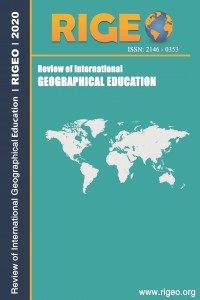Treatment of the theme Islam in German Geographical Education: Case Study of Bavarian Geographical Curriculum
Treatment of the theme Islam in German Geographical Education: Case Study of Bavarian Geographical Curriculum
Several previous studies have looked at the treatment of Islam and Muslim culture in western curricula.
However in Germany, especially in Bavaria where Muslim immigration has been growing since the
1990s, no recent research has covered this theme. As a first step, an exploratory study of Islamic themes
in the curricula of Bavarian secondary schools was undertaken. This article describes the results of this
inquiry, showing the extent to which Muslim themes appear in the curriculum and how the content has
changed through time. The authors analyses the curricula with the help of the quantitative and
qualitative method. The main results are that the theme does not appear in the curriculum over the entire
post-war period. It appears for the first time in the 1970s. The subject appears mostly in the 8th grade.
Students are at the age of 14 for the entire investigation period. The theme is always restricted to the
area of Near and Middle East. Islam is presented as a cultural and environment-creating force in the
orient. The contents of the theme “Islam” are always very short, and in total, the topic is formulated too
generally. Such sparse information can lead to misunderstanding.
Keywords:
curriculum, Islam Bavaria, secondary school,
___
- Apel, H. (1991). Lehrplan- und Curriculumentwicklung in Bayern (1950-1991), München. PimS-Verlag.
- Biener, H. (2007). Herausforderungen zu einer multiperspektivischen Schulbucharbeit, Eine Problemdarstellung anhand einer Lehrplananalyse zur Berücksichtigung des Islam im Religions-, Ethik- und Geschichtsunterricht, Birkach. EB-Verlag.
- Csazar, Z.; Vati, T. (2012). The representation of Islam in the Hungarian Geography textbooks. RIGEO, 2, 2, 181-191.
- Detjen, (2007). Politische Bildung: Geschichte und Gegenwart in Deutschland, OldenbourgVerlag.
- Fischer, G. (1987). Analyse der Geographiebücher zum Thema Islam, Braunschweig. GeorgEckert-Institut.
- Geertz, C. (1991). Religiöse Entwicklungen im Islam, Frankfurt am Main. Suhrkamp-Verlag.
- Haug, S. (2009). Muslimisches Leben in Deutschland, im Auftrag der Deutschen Islam Konferenz. Nürnberg. Bundesamt für Migration und Flüchtlinge.
- Hofstede, G. (2006). Lokales Denken, globales Handeln, Interkulturelle Zusammenarbeit und globales Management, München, Deutscher Taschenbuch Verlag.
- Lidstone, H. (Ed.) (1992). International Charta of geographical education, Australia. Heine, S. (Ed.): Islam zwischen Selbstbild und Klischee. Eine Religion im österreichischen Schulbuch, Böhlau. Böhlau-Verlag.
- Ihtiyar, N. (2004). Der Islam in deutschen Schulbüchern (1995-2002). Geografie. Internationale Schulbuchforschung, 26, 237-248.
- Kehrer, G. 1998. Religion, Definitionen der Religionen. Hubert, C. & Gladigow, B.; Laubsacher, M. (Eds.): Handbuch der religionswissenschaftlichen Grundbegriffe, Bd. 4, 418-425. Kohlhammer-Verlag.
- Konferenz der Kultusminister (1982). Richtlinien für die Genehmigung von Schulbüchern Neuwied.(Eigenverlag).
- Kong, L. (2010). "Global shifts, theoretical shifts: changing geographies of religion". Progress in Human Geography, 34, 6: 755-776.
- Kromrey, H. (2000). Empirische Sozialforschung – Modelle und Methoden der Datenerhebung und Datenauswertung, Opladen. UTB-Verlag.
- Mc Andrew, M. & Queslati, B. (2008). The Coverage of the Muslim World in Quebec French Language High-School Textbooks. Georg Eckert Institut für Internationale Schulbuchforschung: Internationale Schulbuchforschung, 180-200.
- Maletzke, G (1996). Interkulturelle Kommunikation: zur Interaktion zwischen Menschen verschiedener Kulturen, Opladen, Westdeutscher Verlag.
- Mayring, P. (2002). Einführung in die qualitative Sozialforschung: Eine Anleitung zu qualitativem Denken, Klagenfurt.Beltz-Verlag.
- Moosmüller, A. (2007). Interkulturelle Kommunikation als Wissen und Alltagspraxis. SchmidtLauber, B. (Ed.): Ethnizität und Migration. Einführung in Wissenschaft und Arbeitsfelder, Berlin, Reimer Verlag, S. 235–254.
- Miliopouslos, L. (2011): Kulturen, „kulturelle Globalisierung“ und Zivilisation. Mayer, L.; Mayer, R.; Ohly, P.; Weede, E. (Eds.): Globalisierung im Fokus von Politik, Wirtschaft, Gesellschaft eine Bestandsaufnahme, Wiesbaden, Springer Verlag, S. 201-225.
- Osgood, C. (1951). Culture, its empirical and non-empirical character. Southw. J. of Anthr. , 7 202-214.
- Pingel, F. (1999). UESCO Guidebook on textbook research and textbook revision, Hannover. Georg-Eckert-Institut.
- Rinschede, G. (1992). Religionen prägen Räume. Geographie heute, 13,106, 4–8.
- Schultze, H. (1986). Analyse der Richtlinien und Lehrpläne der Bundesrepublik zum Thema Islam, Braunschweig. Georg-Eckert-Institut.
- Shaheen, J. (2004). Arab and Muslim Stereotyping in American Popular Culture. Washington. Center for Muslim-Christian Understanding.
- Smart, N. (1983). Handbuch Weltreligionen, Berlin.
- Tautz, M. (2008). Interreligiöses Lernen im Religionsunterricht: Menschen und Ethos im Islam, Oldenbourg. Oldenbourg-Verlag.
- Tholey, M. (1996). Methodenfrage zur Schulbuchanalyse. Becher, U. (Ed.): Grenzen und Ambivalenzen. Analyse zum Deutschlandbild in den Niederlanden und in niederländischen Schulbüchern, Frankfurt am Main, 97-112.
- Tillmann, K. (1996). Lehrpläne, (K)ein Thema für den Schulalltag? Pädagogik, 5, 7-15
- Tworuschka, U. (1986). Der Islam in den Schulbüchern der Bundesrepublik Deutschland. Analyse der evangelischen Religionsbücher zum Thema Islam, Braunschweig. GeorgEckert-Institut.
- Tworuschka, M. (1986). Analyse der Geschichtsbücher zum Thema Islam, Braunschweig. Georg-Eckert-Institut.
- Waardenburg, J. (1986). Religionen und Religion: Einführung in die Religionswissenschaft, Bonn.
- Vollstädt, W. (2003). Steuerung von Schulentwicklung und Unterrichtsqualität durch staatliche Lehrpläne? In: Füssel, H.& Roeder, P. (Eds.). Recht - Erziehung - Staat. Zur Genese einer Problemkonstellation und zur Programmatik ihrer zukünftigen Entwicklung. Weinheim : Beltz 2003, 194-214.
- ISSN: 2146-0353
- Başlangıç: 2011
- Yayıncı: Eyüp ARTVİNLİ
